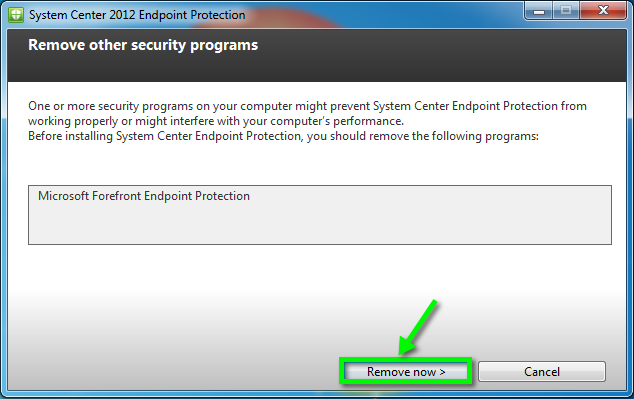

- #SYSTEM CENTER ENDPOINT PROTECTION 2012 HOW TO#
- #SYSTEM CENTER ENDPOINT PROTECTION 2012 INSTALL#
- #SYSTEM CENTER ENDPOINT PROTECTION 2012 MANUAL#
- #SYSTEM CENTER ENDPOINT PROTECTION 2012 SOFTWARE#
- #SYSTEM CENTER ENDPOINT PROTECTION 2012 CODE#
Specify an antimalware policy file to configure the client during installation Then run scepinstall.exe, adding any additional command-line properties that you require: Property Change directory to the folder with the installer. Open a command prompt as an administrator.
#SYSTEM CENTER ENDPOINT PROTECTION 2012 INSTALL#
To install the Endpoint Protection client from a command promptĬopy scepinstall.exe from the Client folder of the Configuration Manager installation folder to the computer on which you want to install the Endpoint Protection client software. If necessary, also include a preconfigured antimalware policy or with an antimalware policy that you previously exported. For more information, see Install the Endpoint Protection client from a command prompt. First get the installation file scepinstall.exe. Install the Endpoint Protection client locally on the reference computer from a command prompt.
#SYSTEM CENTER ENDPOINT PROTECTION 2012 HOW TO#
How to install the Endpoint Protection client on the reference computer

If you want to install the Endpoint Protection client with the latest definitions, download them from Windows Defender Security Intelligence. You can't export the Default Client Antimalware Policy.

After you create the OS image, then use Configuration Manager OS deployment to deploy the image. This computer is typically called the reference computer. Install the Endpoint Protection client on a computer that you intend to use as a disk image source for Configuration Manager OS deployment. How to provision the Endpoint Protection client in a disk image For more information, see Initiate policy retrieval for a Configuration Manager client. The new deployment is shown in the Deployments tab of the details pane.Ĭlients are configured with these settings when they next download client policy. In the Select Collection dialog box, choose the collection to which you want to deploy the client settings and then click OK. In the Home tab, in the Client Settings group, click Deploy. Select the custom client settings you want to deploy. Next, deploy the custom client settings to a collection. The new client settings are displayed in the Client Settings node of the Administration workspace. Once this went out to the clients it was a smooth uninstall of Symantec and a smooth install of System Center Endpoint Protection without bothering the end user or rebooting the client PC.Install the Endpoint Protection site system role before you configure client settings for Endpoint Protection.Ĭlick OK to close the Create Custom Client Device Settings dialog box. HKEY_LOCAL_MACHINE\SOFTWARE\Symantec\Symantec Endpoint Protection\SMC In the registry file add “-“ after “=” on these two keys NOTE: The default password for Symantec Endpoint Protection is symantec. Regedit.exe /s \\SERVERNAME\SHARENAME\removesymantecep.reg This is what was in my batch file:Ĭd C:\Program Files\Symantec\Symantec Endpoint Protection
#SYSTEM CENTER ENDPOINT PROTECTION 2012 SOFTWARE#
I placed my batch file in the packages directory on the SCCM server and pushed it out via software deployment to the clients.
#SYSTEM CENTER ENDPOINT PROTECTION 2012 MANUAL#
I performed a manual install of SCEP just to see what would happen. Programs: Symantec Endpoint Protection LiveUpdate 3.3 (Symantec Corporation) To install System Center Endpoint Protection you must manually uninstall the following programs and then run the wizard again. The System Center Endpoint Protection Setup wizard was unable to remove one or more programs that conflict with System Center Endpoint Protection. HRESULT=0x8004FF67 Description=System Center 2012 Endpoint Protection installation error.
#SYSTEM CENTER ENDPOINT PROTECTION 2012 CODE#
%systemdrive%\WINDOWS\CCM\Logs\EndpointProtectionAgent.logįailed to install endpoint protection client with exit code = 0x8004ff67.ĭetail error message is : Sure enough the require uninstall password was causing the issue. I knew I would run into problems because Symantec Endpoint Protection was on these clients and there was a password required to uninstall it. Recently I had to deploy System Center Endpoint Protection (SCEP).


 0 kommentar(er)
0 kommentar(er)
